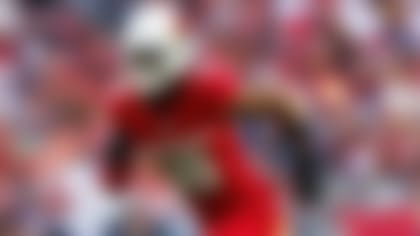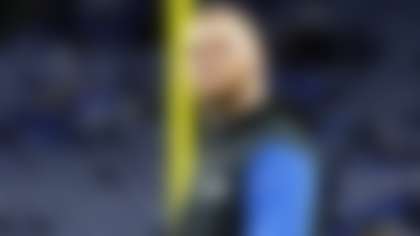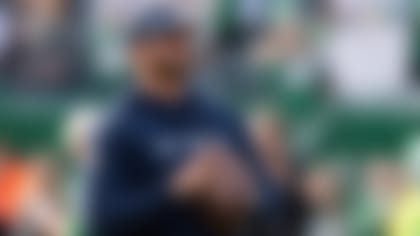NFL Media's Albert Breer touches on multiple topics in his robust Inside the NFL Notebook, including (click on each link to go directly to the topic):
» The trade that changed two franchises, for better and for worse.
» What's next for Jadeveon Clowney?
» Nine coordinators who would be attractive to college programs.
And much more, beginning with the meeting that helped recharge the defending Super Bowl champions. ...
The Seattle Seahawks' season wasn't on life support, but the players noticed something markedly different in how 2014 was going. And to his credit, Pete Carroll did, too.
That's why, before the club welcomed the Arizona Cardinals to CenturyLink Field two Sundays ago, the coach called his leaders in.
"We finally got clear on where we need to focus," Carroll explained late Wednesday afternoon. "It helped us in many ways, and the players were clear about their intentions going forward, and they spread that message. It was awesome to see the leadership take off. That's what happened here. Guys were working hard, busting their tail. But it was clear in the language in the room: The best is still out there for us."
The immediate fallout would certainly back that up.
The Seahawks' vaunted defense is playing like a vaunted defense again -- neither the Cardinals on Nov. 23 nor the 49ers on Thanksgiving got in the end zone -- and Seattle's offense has continued its steady climb off the canvas following an early-season swoon. No one knows better than these guys, of course, that a pair of 19-3 division wins in third quarter of the year won't buy you much in January.
But it's a start, and maybe a sign that the Seahawks are turning the corner on what's afflicted so many recent champions during the title defense. And no doubt, they dealt with some of those. Such as ...
1) The trappings of a title. This is often manifested in the chemistry of a team being challenged -- and Seattle had to navigate choppy water, with some players questioning offensive coordinator Darrell Bevell, and Percy Harvin's temperament hovering under the surface like a land mine. A return to the team's power-running roots and the Harvin trade proved an effective fix.
2) Changing roles. For better or worse, Russell Wilson's star ascended like it was shot from a cannon, and it became more of a test for him -- as it is for many QBs in this kind of circumstance -- to remain one of the guys with the public's rush to make him the guy. "He's well-equipped for it," Carroll said. "But he's a young man, too, just 26 years old. He's working to figure it out. I think that's natural, when you're performing at a high level."
3) Luck running out. A lot of champions benefit from good fortune (see: health), and it's not unusual that the law of averages would short-circuit a repeat bid. Seattle has dealt with that, losing mainstays like Max Unger, Kam Chancellor, Byron Maxwell, Bobby Wagner, Zach Miller and Brandon Mebane for stretches (or longer).
4) Taking everyone's best shot. Carroll explains this, saying, "I think it's the realization of how hard it is to win when everyone's gunning for you. They make fewer mistakes against you, fewer penalties, they don't turn the ball over. It makes games harder. It's not an adjustment, it's just what you deal with. And maybe we just had to see it to believe it."
5) Complacency. This is the obvious pitfall everyone looks for.
Billick: The winning formula?

Brian Billick dives into his favorite statistical study, toxic differential, which smiles upon some notable teams. **READ**
And that last one's where Carroll felt his team would be good, when I talked to him about it in April. As he saw it, the program he and John Schneider had built was never about being the underdog. It was about being a champion from the start.
Now, though, with the benefit of hindsight, Carroll can see that some of those principles needed to be reinforced -- and he was ecstatic to see that happen in the meeting. In his view, it wasn't so much getting fat and happy, as perhaps a team learning to recapture the hunger of the initial chase.
"That's the typical way of looking at it, and that's not wrong," Carroll said. "It's really about reaching out to find your best. It's not that they weren't trying hard. Everyone was working. It's more giving of yourself in a way that allows you to be supportive of one another. You wanna draw the best out of each other, and that's where we needed to get."
That collective has shown up, for sure. The resurgent Seahawks defense -- with Wagner and Chancellor, among others, back -- held the Cardinals to 204 total yards and the Niners to 164. The offense staked the team to halftime leads in both games, playing a physical, efficient -- if unspectacular -- style of ball. And it's come together in the type of complementary game that got Seattle to New Jersey last winter.
The next test, the guys know, is for all of that to show up in tight games.
Carroll mentioned the 2013 Seahawks were 5-3 in their eight one-possession, regular-season games. Seattle is 3-3 in those contests this year -- something that the players have taken note of. And the hope is that, with the leaders pulling, the tough moments become easier, which is what came across when those prominent members of the locker room talked to the coach.
"We had a really clear connection, when it comes to playing as hard as we can play," Carroll said. "That's what it's directed at. That's something you never get to, but you're always reaching for. I think we were able to reconnect with that, and it's taken us up a notch. The way we play defense, we're not trying to fool you, so we need to out-execute you, which calls on you to be at your best every time. We reached deeper for that, we turned to each other for that.
"So I think we've generated the next step. Where we've been, I think we're getting back there. Now, the job is to hold on to that intensity."
Things won't get easier. The Seahawks go cross-country this weekend to play the Eagles, then host their archrivals from San Francisco, go to Arizona and wrap up the season at home against the Rams. If they can win out, and the Cowboys and Packers lose a game each, the road to the Super Bowl will again go through the Pacific Northwest.
But for now, Carroll's eyes are on what's right in front of him, and his team.
"It's about how you finish, not how you start, and this is the first game of the fourth quarter," he said. "But's that's all we're worried about, that one game in Philadelphia. Don't make this come off like I'm making any kind of prediction, because I'm not doing that. It couldn't be clearer to us now how important each game is."
To be sure, the first three months of this particular title defense provide plenty of evidence of that.
Four downs
1) Bronco revival. Everything might not be totally fixed in Denver, but there's evidence now that the Rams loss might have actually been a good thing for the postseason viability of the 2014 Broncos. In that one, the staff (and Peyton Manning) called 56 pass plays against just 10 runs, and the results were dreadful -- the point total (7) was the lowest of the three-year Manning era in Colorado. And that served as a powerful motivator for the Broncos to try and reprise what John Elway's plan has been all along: to build a team around Manning resembling the clubs with which No. 7 won championships in the late 1990s. So, since the Rams loss? The Broncos went 36:35 pass-to-run against the Dolphins and 35:45 pass-to-run against the Chiefs (total: 71 passes, 80 runs). Those were the fifth and sixth games this season in which Manning failed to throw for 300 yards. The Broncos are 6-0 in those games, after going 3-3 in such games last season. And if you want a good example of the team's commitment to the run, look at the Broncos' first six plays after the Dolphins went up by 11 with 2:11 left in the third quarter two weeks ago: pass, run, pass, run, pass, run. If you talk to people there, that was no accident. Yes, C.J. Anderson has been a revelation to some degree. But this is philosophical as much as anything. Even down by double digits late, offensive coordinator Adam Gase, Manning and Co. stuck to the plan. Being able to do that might not make the Broncos more impressive on the Monday morning highlights, but history shows it should make them more effective when it really counts.
2) Revisiting the trade. The seismic impact the Robert Griffin III trade made in D.C. has been micro-analyzed all week. But the fallout has been just as earth-shaking in St. Louis -- and in a much better way. Fact is, the bounty that Griffin's rights wrought for the Rams wasn't just what they were looking for, it's what they needed. And to get that, you need to look at where the club was going in Year 1 of the Jeff Fisher/Les Snead regime. Twenty-four of the 53 players that ended 2011 on the St. Louis roster never played in the NFL again, and the team's books were saddled with the old-system rookie deals of top-two picks Chris Long, Jason Smith and Sam Bradford. Add that together and the team needed to fill the margins with cheaper labor, and lots of it, so the volume of picks that Griffin brought was a godsend. Through the trade, St. Louis got five players who are -- or likely will be -- candidates for second contracts (Michael Brockers, Janoris Jenkins, Stedman Bailey, Alec Ogletree, Greg Robinson), built capital that allowed the deal-up for Tavon Austin, and gave the team the flexibility to deal off picks for Mark Barron at midseason. Of course, there's a flip side, too. The Rams thought they had their franchise quarterback in 2012 (Bradford), which made the trade easier. Obviously, they now have a hole at that position. And while a number of Rams people have affirmed they'd do the deal again, one raised a salient point to me explaining the risk at the time. Say the Colts had the chance to reverse the Luck pick, and instead take home the haul the Rams did. For argument's sake, let's make it Brockers, Indy's 2 that year (Coby Fleener) and what the Colts got out of their 1s in 2013 and '14 (Bjoern Werner and Trent Richardson). Think Ryan Grigson and Chuck Pagano would reach for the Brockers/Fleener/Werner/Richardson package over Luck? Of course not -- which illustrates that hitting on the quarterback (which the Redskins thought they would do) remains the most important thing, and goes a long way in explaining Washington's actions in what now looks like a franchise-razing transaction.
3) Bills trying to simplify. The snowstorm of late November shook the Bills on a number of levels. But it also allowed the offense to grow, in an almost accidental way. Having just played a Thursday night game in Week 11 before the storm hit, the players had over a week without practice before traveling to Detroit and having to cram for a relocated/rescheduled Monday night game against the Jets. The result: The Buffalo players simplified things, cut loose and scored 38 points on a New York defense that prepped all week under relatively normal conditions. "Whenever you watch a player go into a slump, a lot of time, it's them overthinking it," Bills offensive coordinator Nathaniel Hackett told me. "Sometimes, you gotta just go and make it beating the guy in front of you, and if we do that, we have a great chance to get better and better. That was the fun thing about the Jet game." Buffalo followed it up by grinding out 26 points against a stout Cleveland defense last week. And as Hackett sees it, building on what he called a "high school enthusiasm" should help the group going forward, with the expectation that Kyle Orton, Robert Woods and Sammy Watkins are going to keep growing together to supplement an already strong run game and a defense that's playing out of its mind. And they'll sure need to be good, with the Broncos, Packers and Patriots on the schedule in December.
4) Keeping a record. A key passage in NFL executive vice president and general counsel Jeff Pash's letter to the NFLPA was lost in the shuffle earlier in the week, and it's worth raising again as a potential problem going forward in the personal conduct policy: "We respect your concern for a player's Fifth Amendment rights and would accordingly agree to apply the terms of Article 51, Section 11 of the CBA to interviews conducted by independent investigators. We cannot agree to have NFLPA attorneys present for all interviews, or to require that all interviews are recorded and transcribed. This is entirely inconsistent with current business practices and will likely deter witnesses from coming forward or sharing information." The issue that will be raised here is in the record, or lack of one, kept by the league as it interviewed Ray Rice back in June. That's been a problem as the case has gone through the appeal process, and the court of public opinion. And it's likely that the players will push hard for more transparency, not less, in everything the league does from a discipline standpoint.
Three checkdowns
1)Jadeveon Clowney's rookie year ends after four games, two starts and zero sacks. And as I wrote back in early November, Clowney's makeup gives Houston reason to be as cautious as possible with his rehab. As for the rest, the Texans want Clowney to hone in on fundamentals (footwork especially) when he gets healthy. What they believe they have now: a tremendously talented, but very raw player.
2)Mike Pettine told me Sunday that details would guide his QB call -- where his team is, the opponent, where the other 10 guys on offense are. That's why Brian Hoyer was the right guy, for this week. The Browns are contending, the Colts are complex on D, Jordan Cameron is still recovering from a concussion and Josh Gordon has scuffled some in his return. So go with the steady vet. And keep No. 2 close.
3) As we inch closer to the hiring cycle of 2015, much will hinge on the status of Giants coach Tom Coughlin. In the industry, the head job for the Mara family's team has long been seen as the Rolls-Royce of all football coaching jobs. So if that one comes open, the dynamic changes for every other team looking for a new guy -- and that goes especially for the other team in the market.
Two college players to watch Saturday
1) Baylor QB Bryce Petty (vs. Kansas State, 7:45 p.m. ET, ESPN): Petty was knocked out of last week's game with a concussion, but at publishing, he appears on course to play Saturday night. The 6-foot-3, 230-pound senior has been one of the most prolific passers in American over the last two years, but many NFL evaluators see that as a product of a system that props up almost every quarterback who comes through it. "He puts up monster numbers in an offense that doesn't have a history of producing successful pro-style quarterbacks," said one AFC area scout, who compared Petty to Matt Flynn and Drew Stanton. "He's a smart, high-character player. Decent athlete, with a strong lower body, but I personally don't see him as a top prospect." An NFC personnel man added, "He's a big, athletic, smart kid, but he needs to develop (away) from a spread offense to have a chance. Timing and accuracy are the concerns." For his part, Petty has thrown for 7,233 yards, 58 touchdowns and eight picks as a collegian, and playing against the sound, smart Wildcats defense should provide a good test. One thing scouts will be honed in on for this one: Petty's deep-ball accuracy with a talented receiver group around him.
2) Missouri DE Shane Ray (vs. Alabama, 4 p.m. ET, CBS): Remember when people said that Michael Sam wasn't even the best guy on his own defensive line? Ray was one of the guys who was better. And accordingly, he's much more highly regarded in NFL circles than the 2013 SEC Defensive Player of the Year was. Ray leads the conference with 14 sacks, and has 59 tackles, 20.5 tackles for losses, five quarterback hurries, a pass breakup, two forced fumbles and a blocked kick. One AFC general manager said he's a solid first-rounder, while an AFC college director said he's right at the first-round/second-round border, and that a dominant performance against 'Bama's true-freshman left tackle, Cam Robinson, could loom large. "For his team to win, he has to get consistent pressure on the quarterback, not allow him to scramble outside the pocket," said the college director. "He needs to be a difference-maker. This is the game he'll be heavily evaluated on, going against an NFL-caliber tackle." And Ray's not the only Mizzou rusher to follow -- his bookend, Markus Golden, will be watched closely by pro types, as well.
Extra point
The NFL coaching carousel doesn't really start spinning until Black Monday. But with the college cycle in full swing, many eyes in the industry are already on 2015.
And it's not uncommon for college programs to look to the NFL for leaders. In fact, one of the best coaching hires in recent memory came when a school (USC) reached outside the college ranks for a longtime pro coach (Pete Carroll) few expected would have much success.
So this week, with the carousel spinning at Florida, Nebraska, Michigan and Oregon State, among other places, I thought it'd be worthwhile to ask around and come up with a list of NFL coaches (outside of obvious names like Chip Kelly) who would be attractive to college programs. Here's what I came up with, in alphabetical order:
Adam Gase, offensive coordinator, Denver Broncos: Acolytes of Nick Saban have favored status in the college game, and Gase was with the Alabama coach at both Michigan State and LSU. Plus, Gase has a growing rep as an offensive innovator, which is increasingly important in the college game. His preference is to stay in the NFL, but seeing his name kicked around in college searches would hardly be surprising.
Nathaniel Hackett, offensive coordinator, Buffalo Bills: Hackett has the bloodlines (his father is former USC and Pitt coach Paul Hackett) and the experience at just 34 years old to merit a look. He was at Doug Marrone's side for the resurrection of a dormant Syracuse program, and followed the coach to Buffalo. Plus, his background is in the kind of flashy offense that attracts recruits.
Pep Hamilton, offensive coordinator, Indianapolis Colts: Really interesting candidate who's worked for Lovie Smith, Jim Harbaugh, David Shaw and Chuck Pagano over the last half-decade, and has had a hand in Andrew Luck's development as both a collegian and a pro. He's also shown flexibility as a game-planner and play-caller this year, as the Colts have sustained injuries at tailback.
Hue Jackson, offensive coordinator, Cincinnati Bengals: Would be a Carroll-style hire -- a guy with college experience a bit distant in his background who'd figure to be an absolute ace as a recruiter (he nearly got Tom Brady to transfer to Cal, and recruited Carson Palmer to USC). He worked at three Pac-12 schools over a nine-year period, and has extensive experience developing quarterbacks across the NFL.
Dirk Koetter, offensive coordinator, Atlanta Falcons: The oldest guy on this list is one of the coaches responsible for building Boise State. And while his tenure at Arizona State was a disappointment, he has a wide range of experience and skill applicable at the college level. Plus, he's said to have a desire to go back, though it likely would have to be for a middling-type program.
Josh McDaniels, offensive coordinator, New England Patriots: His expertise with quarterbacks, and background with Saban make him attractive. Also, McDaniels is the son of a decorated Ohio high school coach, so he could quickly build relationships vital to recruiting. Urban Meyer thinks highly of him, which probably is why Florida was connected to him before hiring Jim McElwain. He wants to stay in the NFL, but that won't stop schools from calling.
Dan Quinn, defensive coordinator, Seattle Seahawks: Another guy whose focus remains in the NFL, but who lines up as a very serious college candidate. Quinn is another former Saban assistant -- he coached under Saban with the Dolphins in 2005 and '06 -- and has recent college experience, as defensive coordinator at Florida in Will Muschamp's first two years. Interviewed for the NFL head-coaching jobs in Cleveland, Tennessee and Minnesota last year.
Harrison: Power Rankings, Week 14
In the latest edition of his weekly NFL pecking order, Elliot Harrison executes a grand reshuffling of the deck. **READ**
Greg Roman, offensive coordinator, San Francisco 49ers: Another product of Harbaugh Era Stanford, Roman has been under fire in San Francisco, but had his name floated last year for the USC job. He's coached every position except for receiver on offense at the NFL level, and is another one who helped in Luck's development. And even with a lengthy résumé, he's still just 42 years old.
Kyle Shanahan, offensive coordinator, Cleveland Browns: Outside of a one-year apprenticeship at UCLA, Shanahan's experience has come entirely at the pro level, but he did play four seasons for Mack Brown at Texas. And he's incorporated a wide range of college concepts into a pro scheme, helping both Robert Griffin III and Johnny Manziel transition to the NFL.
Follow Albert Breer on Twitter @AlbertBreer.



